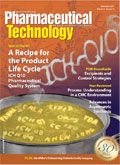In The Field
US and China Crack Down on Regulation after SFDA Chief Executed; Xcellerex Receives US Grant for Biopharmaceutical Production; New FDA Guidance on Polymorphic Compounds in Generic Drugs; Comment Periods Open for ICH Q10 and Biologics Guidelines
INTERNATIONAL
US and China Crack Down on Regulation after SFDA Chief Executed
The People's Republic of China executed one of its former drug safety chiefs, Zheng Xiaoyu, on July 11, 2007, for taking bribes to approve untested pharmaceuticals, including some medicines that contained fake ingredients and led to several deaths. Zheng, who led China's State Food and Drug Administration (SFDA) from 1998 to 2005, was charged and sentenced for taking an estimated 6.5 million yuan, or $850,000, in bribes to pass a number of new pharmaceuticals through the system.
The execution followed a series of negative events tied to China's exports over the past 18 months, including contaminated "made-in-China" products such as pet food, toothpaste, juice, and fish found in the United States, Panama, and other countries. The US Food and Drug Administration has since stepped up inspections and banned imports of several Chinese farm-raised foods to eliminate any potential health risks.

HHS Secretary Mike Leavitt (WWW.HHS.GOV/ABOUT/BIOS/DHHSSEC.HTML)
On the day of Zheng's execution, the Chinese government released a more strict set of drug registration regulations for officials in an effort to close a number of loopholes in the system. According to an SFDA news release, the agency also revoked the production licenses of five drug manufacturers and three factories in the past year and withdrew good manufacturing practice certificates from 128 drugmakers. An ongoing component of the country's food and drug regulation cleanup includes a review of some 170,000 SFDA-issued medicine production licenses, many of which were approved during Zheng's tenure.
"Some applicants' research documentation has been substandard, there have been serious problems with fraud and fakery, and it's been nigh impossible to ensure pharmaceutical safety," said Wu Zhen, deputy head of SFDA, at a July 11 news briefing.
A US delegation of health officials visited China in early August on a fact-finding mission regarding food and drug safety issues. The mission was meant to spark discussions in an effort to create bilateral agreements on food and feed safety, as well as on drug and medical device safety by the year's end, according to a July 30 statement from the US Department of Health and Human Services (HHS).
Specifically, said HHS Secretary Mike Leavitt, the US is looking to attain three things: "better cooperation," "better information," and "to have the Chinese devise and enforce regulations that we can understand, with which we agree, and in which we feel confident."
The result of these and future meetings between US and Chinese representatives will be included in the recommendations of the US Working Group on Import Safety, chaired by Leavitt, to be presented to President George W. Bush this September.
-Angie Drakulich
MANUFACTURING
Xcellerex Receives US Grant for Biopharmaceutical Production
Xcellerex, Inc., based in Marlboro, Massachusetts, received two Phase-I contracts from the Defense Advanced Research Projects Agency for the Accelerated Manufacture of Pharmaceuticals (AMP) program on July 17.
The AMP program is a three-phase program in which the US military is focused on technologies for producing emergency therapeutics and vaccines. Total funding for the two Phase-I contracts is more than $13 million.
Phase I of the AMP program is focused on optimizing host strains that will express a model vaccine and antibody and demonstrate small-scale production. Subsequent phases will be aimed at rapid process optimization, scale-up, and cost-effective production.

Company Notes
Xcellerex will serve as the prime contractor on the first grant, in which the company is collaborating with Dowpharma (Midland, MI), a business unit of The Dow Chemical Company, Biopharm Services (Marlboro, MA), and deltaDOT, Ltd. (London).
On the second contract, Xcellerex is collaborating with Neugenesis Corp. (Burlingame, CA) as the prime contractor, SRI International (Menlo Park, CA), and BioPharm Services. The grant is based on the use of Xcellerex "PDMax" and "FlexFactory" technologies to show the potential of Neugenesis's "NeuBIOS" protein-production platform. Neugenesis and SRI will provide project management and integration systems for the team.
-Patricia Van Arnum
GENERICS
New FDA Guidance on Polymorphic Compounds in Generic Drugs
A new guidance issued by the US Food and Drug Administration on July 9, advises companies on how to treat polymorphic drug compounds—those that exhibit multiple structural forms—in filing abbreviated new drug applications (ANDAs). The bottom line, according to the guidance, is that generic drug products containing the polymorphs be the "same" as the reference listed drug (RLD) in active ingredients, bioavailability, and bioequivalence. The guidance pertains to orally available drugs that are either solid- or suspension-dosage products.
Polymorphisms arise when compounds are identical chemically, but not structurally. This can happen when two solids take on different crystalline forms such as graphite and diamond; when molecules are disordered and fail to produce a repeatable crystal lattice, as is the case for the molecules in glass; or when solvent is trapped inside the crystal structure—as in hydrates, where water molecules are found within crystals. The guidance notes that different polymorphisms may alter physical properties of compounds and affect their solubility, which in turn can alter their bioavailability or bioequivalence. In addition, polymorphic forms of a compound may alter the way the compound behaves during production, which again, may alter the finished drug's biological activities. On this latter point, the guidance specifically states, "Since an ANDA applicant should demonstrate that the generic drug product can be manufactured reliably using a validated process, we recommend that you pay close attention to polymorphism as it relates to pharmaceutical processing."

(IMAGE OF CRYSTAL: TU LEE)
The guidance also emphasizes the effect polymorphisms may have on drug stability, which again, may alter the drug's biological activity. But the guidance goes on to say that "it is the stability of the drug product and not stability of the drug substance polymorphic form that should be the most relevant measure of drug equality." Otherwise, a generic drug can be considered the "same" as the active ingredient in an RLD if the generic compound conforms to the standards set out in a United States Pharmacopeia (USP) monograph, if one exists for that particular drug substance. These standards generally include the chemical name, empirical formula, and molecular structure of the compound. However, the "FDA may prescribe additional standards that are material to the sameness of a drug substance." But as concerns polymorphisms, the guidance goes on to say "...differences in drug substance polymorphic forms do not render drug substances different active ingredients for the purposes of ANDA approvals...." Finally, the guidance reminds ANDA applicants that the biological performance characteristics of a drug are also dependent on the drug's formulation and advises applicants to consider the properties of both the drug substance and formulation excipients, when assessing "sameness."
-Michelle Hoffman
REGULATION
Comment Periods Open for ICH Q10 and Biologics Guidelines
The US Food and Drug Administration announced in mid-July the International Conference on Harmonization (ICH) draft guidance Q10 Pharmaceutical Quality System in the Federal Register (Docket 2007D-0266, CDER 200783). The ICH Q10 draft guideline, which is open for public comment until Oct. 11, describes one approach for "an effective pharmaceutical quality system that is based on ISO concepts, includes applicable good manufacturing practice (GMP) regulations and complements ICH Q8 'Pharmaceutical Development' and Q9 'Quality Risk Management.'" The guideline, which is optional, applies to pharmaceutical drug substances and drug products, including biotechnology and biological products, throughout the product lifecycle.
FDA also opened for public comment until Sept. 21, its draft guidance for industry, Cooperative Manufacturing Arrangements for Licensed Biologics. The announcement, released in the Federal Register (Docket 1999D-2013), relates to "cooperative manufacturing arrangements applicable to biological products licensure under section 351 of the US Public Health Service Act," including short-supply, divided manufacturing, shared manufacturing, and contract manufacturing arrangements.

Company Notes
Primary topics covered in the document include reporting and recordkeeping responsibilities relating to these arrangements for the licensed manufacturer, contract manufacturer, and final-product manufacturer.
-Maribel Rios

Drug Solutions Podcast: A Closer Look at mRNA in Oncology and Vaccines
April 30th 2024In this episode fo the Drug Solutions Podcast, etherna’s vice-president of Technology and Innovation, Stefaan De Koker, discusses the merits and challenges of using mRNA as the foundation for therapeutics in oncology as well as for vaccines.
Drug Solutions Podcast: Gliding Through the Ins and Outs of the Pharma Supply Chain
November 14th 2023In this episode of the Drug Solutions podcast, Jill Murphy, former editor, speaks with Bourji Mourad, partnership director at ThermoSafe, about the supply chain in the pharmaceutical industry, specifically related to packaging, pharma air freight, and the pressure on suppliers with post-COVID-19 changes on delivery.